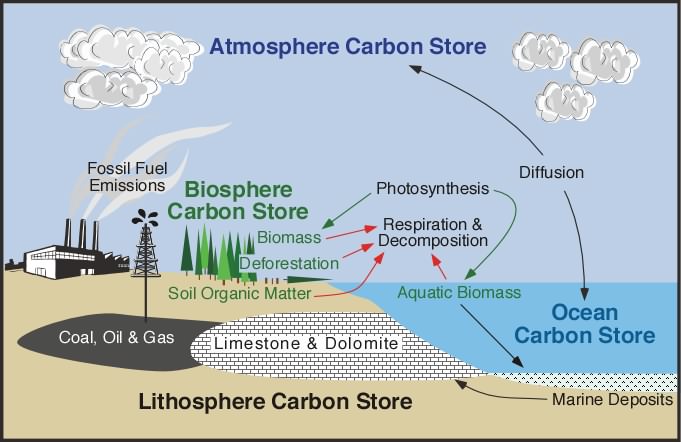All life is based on the element carbon. Carbon is the major chemical constituent of most organic matter, from fossil fuels to the complex molecules (DNA and RNA) that control genetic reproduction in organisms. Yet by weight, carbon is not one of the most abundant elements within the Earth's crust. In fact, the lithosphere is only 0.032% carbon by weight. In comparison, oxygen and silicon respectively make up 45.2% and 29.4% of the Earth's surface rocks.
Carbon is stored on our planet in the following major sinks (Figure 9r-1 and Table 9r-1): (1) as organic molecules in living and dead organisms found in the biosphere; (2) as the gas carbon dioxide in the atmosphere; (3) as organic matter in soils; (4) in the lithosphere as fossil fuels and sedimentary rock deposits such as limestone, dolomite and chalk; and (5) in the oceans as dissolved atmospheric carbon dioxide and as calcium carbonate shells in marine organisms.

Figure 9r-1: Carbon cycle.
Table 9r-1: Estimated major stores of carbon on the Earth.
| Sink |
Amount in Billions of Metric
Tons |
| Atmosphere |
578 (as of 1700) - 766 (as
of 1999) |
| Soil Organic Matter |
1500 to 1600 |
| Ocean |
38,000 to 40,000 |
| Marine Sediments and Sedimentary Rocks |
66,000,000 to 100,000,000 |
| Terrestrial Plants |
540 to 610 |
| Fossil Fuel Deposits |
4000 |
Ecosystems gain most of their carbon dioxide from the atmosphere. A number of autotrophic organisms have specialized mechanisms that allow for absorption of this gas into their cells. With the addition of water and energy from solar radiation, these organisms use photosynthesis to chemically convert the carbon dioxide to carbon-based sugar molecules. These molecules can then be chemically modified by these organisms through the metabolic addition of other elements to produce more complex compounds like proteins, cellulose, and amino acids. Some of the organic matter produced in plants is passed down to heterotrophic animals through consumption.
Carbon dioxide enters the waters of the ocean by simple diffusion. Once dissolved in seawater, the carbon dioxide can remain as is or can be converted into carbonate (CO3-2) or bicarbonate (HCO3-). Certain forms of sea life biologically fix bicarbonate with calcium (Ca+2) to produce calcium carbonate (CaCO3). This substance is used to produce shells and other body parts by organisms such as coral, clams, oysters, some protozoa, and some algae. When these organisms die, their shells and body parts sink to the ocean floor where they accumulate as carbonate-rich deposits. After long periods of time, these deposits are physically and chemically altered into sedimentary rocks. Ocean deposits are by far the biggest sink of carbon on the planet (Table 9r-1).
Carbon is released from ecosystems as carbon dioxide gas by the process of respiration. Respiration takes place in both plants and animals and involves the breakdown of carbon-based organic molecules into carbon dioxide gas and some other compound by products. The detritus food chain contains a number of organisms whose primary ecological role is the decomposition of organic matter into its abiotic components.
Over the several billion years of geologic history, the quantity of carbon dioxide found in the atmosphere has been steadily decreasing. Researchers theorized that this change is in response to an increase in the Sun's output over the same time period. Higher levels of carbon dioxide helped regulate the Earth's temperature to levels slightly higher than what is perceived today. These moderate temperatures allowed for the flourishing of plant life despite the lower output of solar radiation. An enhanced greenhouse effect, due to the greater concentration of carbon dioxide gas in the atmosphere, supplemented the production of heat energy through higher levels of longwave counter-radiation. As the Sun grew more intense, several biological mechanisms gradually locked some of the atmospheric carbon dioxide into fossil fuels and sedimentary rock. In summary, this regulating process has kept the Earth's global average temperature essentially constant over time. Some scientists suggest that this phenomena is proof for the Gaia hypothesis.
Carbon is stored in the lithosphere in both inorganic and organic forms. Inorganic deposits of carbon in the lithosphere include fossil fuels like coal, oil, and natural gas, oil shale, and carbonate based sedimentary deposits like limestone. Organic forms of carbon in the lithosphere include litter, organic matter, and humic substances found in soils. Some carbon dioxide is released from the interior of the lithosphere by volcanoes. Carbon dioxide released by volcanoes enters the lower lithosphere when carbon-rich sediments and sedimentary rocks are subducted and partially melted beneath tectonic boundary zones.
Since the Industrial Revolution, humans have greatly increased the quantity of carbon dioxide found in the Earth's atmosphere and oceans. Atmospheric levels have increased by over 30%, from about 275 parts per million (ppm) in the early 1700s to just over 365 PPM today. Scientists estimate that future atmospheric levels of carbon dioxide could reach an amount between 450 to 600 PPM by the year 2100. The major sources of this gas due to human activities include fossil fuel combustion and the modification of natural plant cover found in grassland, woodland, and forested ecosystems. Emissions from fossil fuel combustion account for about 65% of the additional carbon dioxide currently found in the Earth's atmosphere. The other 35% is derived from deforestation and the conversion of natural ecosystems into agricultural systems. Researchers have shown that natural ecosystems can store between 20 to 100 times more carbon dioxide than agricultural land-use types.